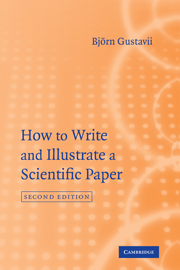Book contents
- Frontmatter
- Contents
- Preface
- Acknowledgments
- 1 Basic rules of writing
- 2 Comments on scientific language
- 3 Drafting the manuscript
- 4 Choosing a journal
- 5 Preparing a graph
- 6 Drawings
- 7 Figure legends
- 8 How to design tables
- 9 Title
- 10 Authors
- 11 Abstract
- 12 Introduction
- 13 Methods
- 14 Results
- 15 Discussion
- 16 Acknowledgments
- 17 References
- 18 Ph.D. and other doctoral theses
- 19 Letters and case reports
- 20 Numbers
- 21 Abbreviations
- 22 How to present statistical results
- 23 Typing
- 24 Dealing with editors and referees
- 25 Correcting proofs
- 26 Authors‘ responsibilities
- Literature needed on your desk
- Further reading
- Literature cited
- Index
14 - Results
Published online by Cambridge University Press: 05 June 2012
- Frontmatter
- Contents
- Preface
- Acknowledgments
- 1 Basic rules of writing
- 2 Comments on scientific language
- 3 Drafting the manuscript
- 4 Choosing a journal
- 5 Preparing a graph
- 6 Drawings
- 7 Figure legends
- 8 How to design tables
- 9 Title
- 10 Authors
- 11 Abstract
- 12 Introduction
- 13 Methods
- 14 Results
- 15 Discussion
- 16 Acknowledgments
- 17 References
- 18 Ph.D. and other doctoral theses
- 19 Letters and case reports
- 20 Numbers
- 21 Abbreviations
- 22 How to present statistical results
- 23 Typing
- 24 Dealing with editors and referees
- 25 Correcting proofs
- 26 Authors‘ responsibilities
- Literature needed on your desk
- Further reading
- Literature cited
- Index
Summary
As the reporting of the randomized controlled trial covers most aspects of the principles of scientific writing, I have used it as a model for this chapter. This approach spares us tedious repetition. The chapter therefore has two parts: the flow of participants and their follow-up; and the outcome of the study.
This seemingly fine flow chart (14.1) would have been even more informative if it had included two additional boxes above the first one, giving the numbers of patients screened and excluded. Here is part of a flow chart with such information.
Only 1904 of the 25 624 potential subjects were selected. This information is useful to have in case you intend to make a confirmatory study. In the main text of this paper, the reasons for exclusion were given in detail. Such data can help readers to assess potential bias in patient selection.
Dropouts
A high rate of withdrawal (say 15 percent or more) can invalidate the conclusions of the study (Lang and Secic 1977, 24). The number of dropouts and their reasons for withdrawal should be reported for each group separately.
Moreover, dropouts should be included in the analysis of the study on an “intention-to-treat” basis. This is often neglected and can result in incorrect reporting. If you simply ignore the drop-outs and if, for example, the reason for their exclusion is chiefly the side effects of the new treatment tested, then the ensuing comparison would be biased in favor of this treatment.
- Type
- Chapter
- Information
- How to Write and Illustrate a Scientific Paper , pp. 68 - 73Publisher: Cambridge University PressPrint publication year: 2008



